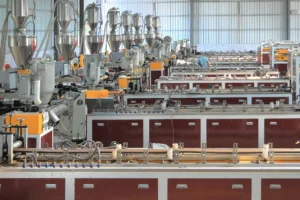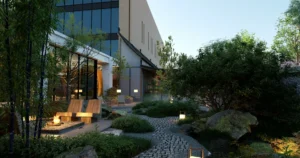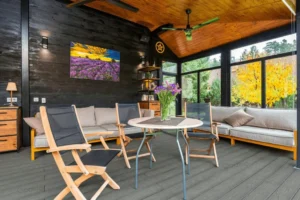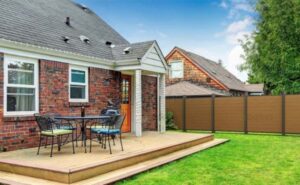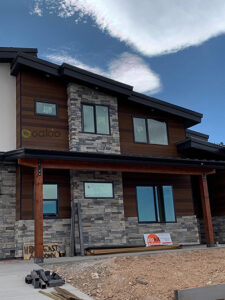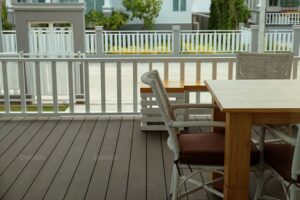Why Choose Wood-Plastic Grilles for Exteriors and Interiors
Wood-plastic grilles, especially the wood-plastic grille ceiling, have gained significant popularity as a building material in recent years. Known for their health and environmental benefits, unique designs, and strong decorative effects, these materials have earned wide market recognition. They are now commonly used in both indoor and outdoor spaces. This trend reflects people’s desire to bring natural elements into their living spaces, all while meeting practical and aesthetic needs.
Key Features of Wood-Plastic Grilles:
- – Eco-Friendly: Made from non-toxic materials, wood-plastic grilles are free from harmful substances like formaldehyde, making them a safer option for indoor and outdoor use.
- – Durability: These grilles are waterproof, flame-retardant, termite-resistant, and resistant to aging, making them ideal for long-lasting applications.
- – Versatility: Wood-plastic grilles can be used in a variety of settings, from residential homes to large-scale commercial projects like ecological parks, museums, hotels, and conference rooms.

Why Choose Wood-Plastic Grilles for Your Next Project?
- – Sustainability: They offer a sustainable solution by using materials that are eco-friendly and free of toxic substances.
- – Long-Term Investment: With features like fire resistance and termite protection, these materials provide a long-lasting, low-maintenance alternative to traditional wood.
Aesthetic and Functional Benefits:
- – Visual Appeal: The uniform color and elegant design of wood-plastic grilles help create a warm, welcoming atmosphere in any space.
- – Cost-Effective: Compared to natural wood, wood-plastic materials are often more affordable and require less maintenance over time.
- – Easy Installation: These grilles are easy to install and can be repeatedly disassembled and reassembled, offering flexibility for future renovations or adjustments.
Eco-Friendly and High-Performance Materials
Wood-plastic grilles are not only beautiful but also high-performance materials. They are made from high-quality aluminum alloy boards, ensuring durability while maintaining aesthetic appeal. The material promotes good ventilation and allows easy integration with fire sprinklers, HVAC systems, and other utilities without compromising the visual integrity of the space.
- – Durable and Low-Maintenance: These materials are long-lasting and require minimal upkeep, often lasting over 10 years in indoor environments without fading or losing their color.
- – Improved Ventilation: With its open-grid design, wood-plastic grille ceilings facilitate better airflow, which is important for spaces like offices, hotels, and restaurants.
Why Wood-Plastic Grilles Are Perfect for Large-Scale Projects:
- – Versatile Design: Available in various grid sizes (100x100mm, 150x150mm, 200x200mm, 300x300mm), they offer great flexibility in design and customization.
- – Easy Access to Utilities: The open-grid structure makes it easy to maintain air conditioning, fire systems, and other pipes and electrical systems, ensuring that your ceiling doesn’t just look good but is also practical for modern buildings.
Exceptional Processing Performance
Wood-plastic grilles are easy to work with, making them an excellent choice for both DIY projects and professional installations. The material can be nailed, drilled, cut, glued, and fixed using screws or bolts—just like traditional wooden ceilings.
- – Smooth Surface: The surface of wood-plastic grilles is smooth and requires no sanding or painting, saving time and labor.
- – Customization: If desired, the grilles can be painted with ease, thanks to their excellent paint adhesion, which allows for personal customization to match your style.
Advantages Over Traditional Wood Ceilings
- – No Cracking or Warping: Unlike natural wood, which can crack or warp over time, wood-plastic grilles offer superior dimensional stability.
- – No Knots or Uneven Grains: Wood-plastic materials are free from the common defects of natural wood, like knots and irregular grain patterns.
Durability and Low Maintenance Costs
Wood-plastic grilles have a significant edge over traditional wooden ceilings when it comes to durability and low maintenance:
- – Weather Resistance: They are resistant to water, moisture, fire, corrosion, insects, fungi, and acids, making them perfect for both indoor and outdoor use.
- – Longer Lifespan: The material’s high strength and resistance to wear and tear ensure a longer lifespan than natural wood and plastic materials.
Why Wood-Plastic Grilles Are the Future of Ceiling Materials:
- – Health-Conscious Design: With increasing demand for eco-friendly and non-toxic materials, wood-plastic grilles meet the needs of today’s environmentally-conscious consumers.
- – Customization Options: The ability to add colorants, laminate surfaces, or create composite layers gives you the flexibility to design a ceiling that matches your space’s aesthetics.
- – Superior Performance: Beyond aesthetics, these materials are designed to be durable, weather-resistant, and easy to maintain, making them the ideal choice for modern buildings.
Wood-plastic grilles not only fulfill the modern demand for sustainable, environmentally friendly products, but also offer a level of versatility and performance that traditional materials can’t match. Whether you’re designing a residential home or undertaking a large commercial project, wood-plastic grilles are a smart choice for achieving both style and functionality.
Trending Reading
What Are the Differences Between the WPC Board and PVC Board?
[2024 Update] How Long Does WPC Decking Last?
